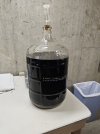- Joined
- Jan 17, 2025
- Messages
- 17
- Reaction score
- 13
- Points
- 3
Brewed my 3rd batch of beer and this was my 1st stout and had a bunch of issues with the brew. The first thing I did wrong was not pre-heating the mash water to temp before adding the grain. The second issue i had was that i didnt use any rice husks in the grain bill which caused the 3rd problem with the fly sparge. The grain bed started out flowing nicely but shortly into the sparge it would stop flowing. I ended up taking the mash out of the lauter and then trying to re-bed on a cleaned false bottom filter it to no avail. I had to slowly move the grain from the bottom to get all of the sparge water to get into the wort. This caused a large amount of sediment to get into the wort. Pitched the recommended amount of irish ale yeast that was harvested from the brew before and placed into fermentation. 1 week in it went from 1.051 to 1.026. 2 weeks later it stopped at 1.021 when the projected FG was 1.015. Looked great but had a slight vinegar taste and smell to it. Bottled it and am now 1 week into conditioning. Do you think the yeast is what is causing the issue of smell and taste? There is no evidence of a bacterial infection. Will it fix itself during conditioning or is it a lost batch?












